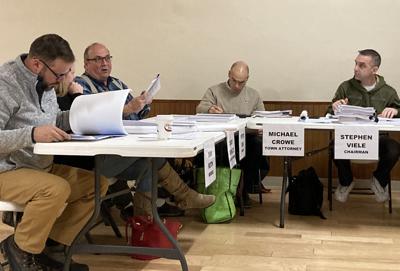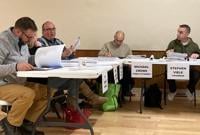TOWN OF FLORIDA — The Florida Planning Board is close to accepting the Environmental Impact Statement (EIS) evaluating concerns related to the wind turbine proposed by New Leaf Energy.
Although the board determined the draft EIS is incomplete, Chairman Stephen Viele on Monday pointed to the likelihood that additionally requested information can be returned before next month’s meeting in order to potentially set the matter for a public hearing in March.
“This study was way more in depth,” Viele said, referencing the voluminous reports submitted to the board. “Everything we asked for was completed in the study versus the first one.”
LaBella Associates, the firm hired by New Leaf to prepare the analysis, submitted several updated reports in response to the Planning Board’s previous determination that the draft EIS was incomplete in September.
The 4.3-megawatt community wind project proposed at 153 YMCA Road has been under review for over a year. The EIS analyzing potential impacts and identifying mitigation options was required after the board determined the 650-foot tall turbine would have significant adverse impacts under State Environmental Quality Review (SEQR) in December 2022.
Fierce criticisms have been leveled at the proposal by residents arguing the turbine would forever alter the landscape of the rural community and subject homes around the site to noise, light and other disturbances. Meanwhile, developers say the project would provide a source of renewable energy supporting the local grid, while offering residents discounts on their power bills.
The board is presently only determining whether all relevant information has been presented before the analysis is used to assess impacts from the project and their ability to be mitigated before a final SEQR determination is rendered. The board will subsequently go on to either approve or deny the project.
“The board isn’t charged right now with determining whether or not there would be an environmental impact, just determining whether the document — draft EIS — is complete enough for review,” Town Attorney Michael Crowe said.
Board members signaled they were satisfied with nearly all of the information in the updated report. Only a more complete explanation was requested on the options to mitigate potential interference to radio frequencies from the turbine.
Peter Rea, a board member and amateur radio user, has been pushing for more information about the potential impacts from the project on radio transmissions throughout the review. Such details were not readily available from device manufacturers or independent studies.
As an alternative, present transmission capabilities were measured to compare to future conditions should the turbine be approved and constructed. The baseline data would be used to verify whether the renewable energy device causes interference and to what extent.
Any impact on radio frequencies from the turbine would not be known until after it is installed. Proposed mitigation would involve the “provision of alternative service” for affected signals or, if unavailable, the establishment of a monetary fund to compensate negatively impacted users.
Board members agreed more specific details are needed regarding the establishment and size of the fund, how compensation would be determined and who would be in charge of the fund and related decisions. They were otherwise satisfied with the data.
“I might be in that boat, so I want to know,” Rea said.
Bee concerns
Meanwhile, a 277-page report on the potential impact of the proposed turbine on honey bees was only briefly discussed. As part of the report, LaBella studied local bee populations over the course of three days for a combined total of five hours in early October.
The report found the project area “does not appear to have greater habitat value for honey bees than the habitat available to and immediately surrounding the locations of honey bee colonies within the four mile range of concern around the study area.”
Furthermore, the report claims research has shown there is no direct impact on hive health, mortality, navigation, reproduction or honey production citing a study, “Is it safe for honey bee colonies to locate apiaries near wind turbines,” published last year in the peer-reviewed journal, “Entomologia Generalis.”
That scientific study involving 129 honey bee colonies was conducted at two wind farms in France in early June and July 2020. While no negative effects from wind turbines were shown under study conditions, researchers stated they were unaware of any other published studies looking for such impacts and additional studies would be needed to confirm their results.
Additionally, LaBella attempted to support those findings anecdotally with honey farms near turbine sites in the state. Only one out of three contacted farms spoke with the firm. The farm reported there had been no difference for their operation since turbines were installed around 15 years ago within half a mile of some of their 1,500 colonies. The names of the farms were withheld in the report to maintain privacy.
“I’m not an expert on studies concerning bees, I wouldn’t feel in a position to challenge that,” Rea said of the findings in the report.
The board did not consult a pair of local bee experts sitting in the front row throughout the meeting. Lori and Mark Rulison, of Rulison Honey Farms, were dismayed by the board’s response to the report they say fails to address the concerns for their 130-year-old family farm on Shellstone Road less than a mile from the project site.
“I’m disappointed they didn’t even bother to ask us what our feelings are and we’re not allowed to speak during the meeting,” Lori Rulison said afterward.
The board previously eliminated public comment from regular meetings. Residents can only speak when public hearings on particular projects are scheduled. Viele indicated it would have been out of order to call on the residents during the board discussion.
“There is a procedure,” Viele said. “The public hearing is when the public has their time to say something.”
The change was made to bring order to meetings that used to extend late into the night with public comment at the end, when residents would sometimes bring up issues not directly before the board. Viele noted written correspondence can be submitted to the board at any time.
Regardless, Lori Rulison said the report from LaBella doesn’t address the potential impacts of the turbine on the honey farm's roughly 2,000 hives — each with tens of thousands of bees — maintained on their property and outyards throughout the area.
“Once again, they did not address what we’re asking for,” Lori Rulison said. “We’re asking for some studies on turbine effects on bees and what we got was a population survey, a habitat assessment, a long 200-page report on foraging behavior … They don’t have to assess that, we know what it is.”
She was explicit about what she felt should be examined during extensive conversation with the planning firm by phone and email before the site survey was conducted over a limited period in the fall — outside of the normal bee foraging season and when only one nectar producing flower was in bloom.
“There isn’t a turbine there yet. They don’t know what’s going to happen,” Lori Rulison said. “It’s all guesswork and if something happens we’ll mitigate by planting more flowers, that’s their answer.”
If there is a negative effect on bees from the turbine, Mark Rulison pointed out that plans by the developer to reseed any disturbed land with a pollinator mix to improve the habitat would only draw more insects to the site and potentially worsen any impacts from the device.
There is still time for these issues to be raised before a decision is made on the potential environmental impacts from the proposed turbine and on the overall application, according to Viele.
“At this point, the board feels we got the information we needed,” Viele said. “When we do finally accept the drafting document, then the public will have their comment.”









